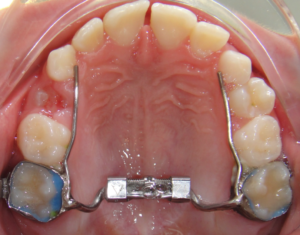With the new year starting, getting your teeth fixed might be, or should be part of your New Years Resolutions! Whether it is for your child or for yourself it could be a good idea to see an orthodontist. Knowing the difference between Phase I and Phase II treatment can help give you a better understanding of how soon to have your child looked at and the importance of it.
Let's start with Phase I, or early age orthodontics. This phase of treatment can be very useful in cases when patients have crowding, misaligned bites, jaw discrepancies, and or protruding teeth. Phase I treatment usually starts in young patients between 7 to 10 years old. A child is still growing and developing with a mix of baby teeth and adult teeth during this age range. This gives the perfect advantage to start correcting dental issues before they can get worse.
Some options for Phase I treatment include retainers, palate expanders, space maintainers, braces, and in some cases Invisalign. Removable retainers can help teeth stay in place to prevent shifting, guiding adult teeth into place, and even help with jaw development. Space maintainers will aid in maintaining the space needed to allow the adult teeth to grow and erupt correctly. Palate expanders help with correcting jaw growth problems in patients with narrow palates. Expanding the palate will make teeth less crowded and make room for the proper alignment of adult teeth. The use of limited braces is typically for cases when patients have overcrowding or issues with their bite.
All in all, Phase I orthodontics will do the early work in guiding the adult teeth in the right direction, whether its making space or maintaining the space for them to develop.




This now leads us into the next phase of treatment, Phase II orthodontics. Some patients who were in Phase I treatment will still need Phase II treatment later on, but less work is needed. Other patients do not need Phase I treatment and will just begin with Phase II.
Depending on how severe the misalignment of the teeth are, or if there are any jaw discrepancies or impacted teeth, it would be important for the patient to begin their treatment sooner than later.
The most common treatments in Phase II orthodontics include braces, traditional or clear brackets, and clear aligners, usually Invisalign. Both treatments can succeed in fixing misalignment or malocclusions based on what the patients needs are. It also depends on preferences, if you do not prefer to have the braces showing, maybe clear brackets or clear aligners would suit you best. In certain cases, extractions may be a necessity to make room for overcrowded teeth. If a patient has impacted teeth they may need surgery to expose the tooth and guide it in the right direction. The orthodontist will develop a treatment plan that will go over all of the expectations throughout your treatment.



To conclude, the main difference between Phase I and Phase II orthodontic treatment, is the desired result. Phase I aims to fix urgent issues that cannot wait until the permanent teeth develop. Whereas Phase II is important in making sure the adult teeth come together in proper alignment.
Setting up a consultation with your local orthodontist would be a good idea, especially when it comes to whether your child will need Phase I treatment or not. Dr. Kennell of Laconia, Plymouth, and Littleton, NH offers free consultations and will inform you if Phase I treatment is needed or if there is still time to wait!

